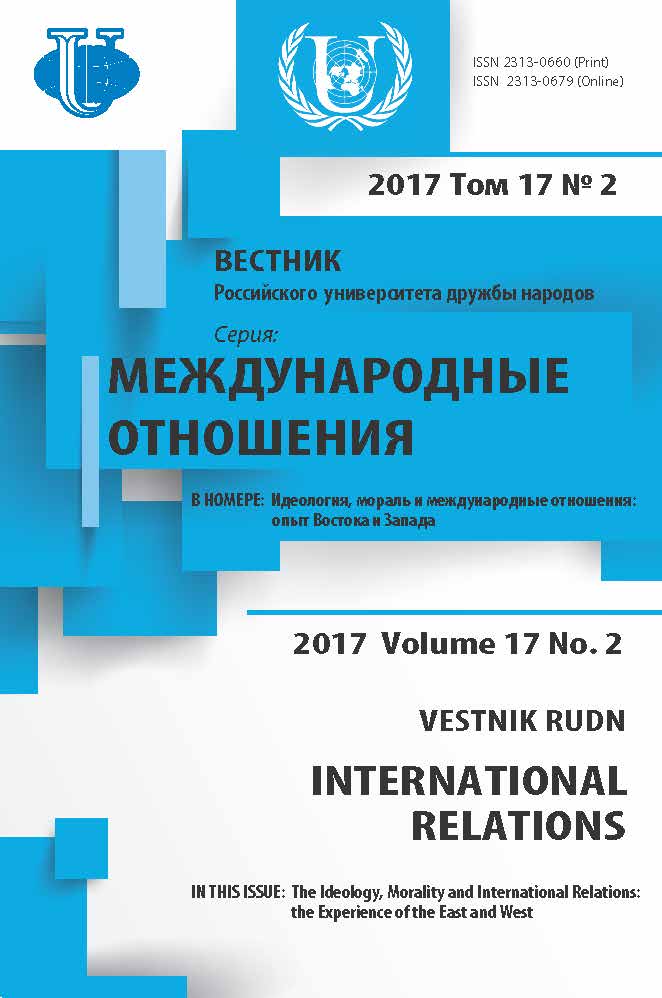Jesuit strategy in Japan and India in the 16th Century as a precursor to modern Western “Soft Power”
- Authors: Volosyuk O.V.1, Nesterova O.A.1, Solodkova O.L.1
-
Affiliations:
- National Research University Higher School of Economics
- Issue: Vol 17, No 2 (2017): The Ideology, morality and international relations: the experience of the East and West
- Pages: 391-401
- Section: HISTORY OF INTERNATIONAL RELATIONS
- URL: https://journals.rudn.ru/international-relations/article/view/16072
- DOI: https://doi.org/10.22363/2313-0660-2017-17-2-391-401
Cite item
Full Text
Abstract
The principles of “soft power”, within the context of the historical development of international relations both on the worldwide and regional levels, had been applied in the East and in the West long before the aforementioned theories appeared. It was the Jesuits in the 16th Century who developed strategies of influence and were pioneers in the introduction of “soft” methods of leverage in international communication practice. In today’s world, which is witnessing an increase in the role of the religious factor in international relations, it is important to understand how to identify these achievements, and correct the mistakes of these early strategies, based on the practices of Francis Xavier in Japan and of Antoni de Montserrat in the Mughal Empire. An attentive and thorough study of the Jesuits’ experience is of great importance in understanding contemporary processes of international interaction from a “soft power” point of view.
About the authors
Olga Vilenovna Volosyuk
National Research University Higher School of Economics
Email: ovolosiuk@hse.ru
Moscow, Russia
Olga Alexandrovna Nesterova
National Research University Higher School of Economics
Email: onesterova@hse.ru
Moscow, Russia
Olga Leonidovna Solodkova
National Research University Higher School of Economics
Email: olsolodkova@hse.ru
Moscow, Russia
References
- Abé, T. (2011). The Jesuit Mission to New France: A New Interpretation in the Light of the Earlier Jesuit Experience in Japan. Leiden: Brill
- Brockey, L. M. (2007). Journey to the East: The Jesuit Mission to China, 1579-1724. Cambridge, MA: Harvard University Press
- Fox, J., Sandler S. (2004). Bringing Religion into International Relations. Basingstoke, UK: Palgrave Macmillan
- Haynes, J. (2014). Religion in Global Politics. Harlow: Longman
- Hosne, A.C. (2013). The Jesuit Missions to China and Peru, 1570-1610: Expectations and Appraisals of Expansionism. London - New York: Routledge
- Lach, D. (1965). Asia in the Making of Europe The Century of Discovery. Book 2. Chicago: University of Chicago Press, Vol. 1
- Monserrate, A. (2006). Embajador en la corte del Gran Mogol: viajes de un jesuita catalán del siglo XVI por la India, Paquistán, Afganistán y el Himalaya. Alay Josep Lluis (ed.). Lleida: Editorial Milenio
- Monserrate, A. (1992). The commentary of Father Monserrate, S. J., on his journey to the court of Akbar. Ed. by Hoyland, S. N. Banrjee, R. R. Dewhurat. Bombay - Oxford: University Press
- Sola, E. (2013). “España y Japón en el Siglo de Oro: historia de un desencuentro”, Japón y España: acercamientos y desencuentros (siglos XVI y XVII). María Jesús Zamora Calvo (coord.). Gijon: Satori
- Sola, E. (1999). Historia de un desencuentro: España y Japón, 1580-1614. Madrid: Fugaz Ediciones
- De Souza Teotonio, R. (1994). Discoveries, Missionary Expansion, and Asian Cultures. New Delhi: Concept Pub. Co
- Subrahmanyam, S. (2011). Explorations in Connected History. Mughals and Franks, New Delhi - Oxford, University Press
- Takashi, G. (1990). Nihon Kirisutokyōshi. Tokio: Yoshikawa Kōbunkan
- Takizawa, O. (2010). La historia de los Jesuitas en Japón, Alcalá de Henares: Universidad de Alcalá
- Thomas, S. (2005). The Global Transformation of Religion and the Transformation of International Relations. The Struggle for the Soul of the Twenty-First Century. New York / Basingstoke, UK: Palgrave Macmillan
- Vernet, J. (2001). Carta de Juan Vernet a Soledad Gibert acerca de las aventuras de una jesuita en la India. In: Anaquel de Estudios Árabes. Vol. 12. Universidad Complutense de Madrid
- Vinogradov, A. V. (2006). State-political “codes” of the East and West. Intenational Trends, 4 (1), 4-20. (in Russ.)
- Xavier, F. (1872). The life and letters of St. Francis Xavier. Vol. 2. Ed. by Henry James Coleridge. London: Burns and Oates, Vol. 2











